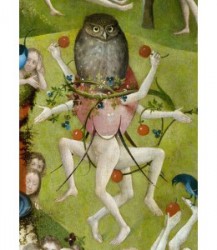
Lurker 1967a
“Die Pflanze in der Bildwelt des Hieronymus Bosch” (Manfred Lurker) 1967
[in: Studium Generale, 20 (1967), pp. 342-351)]
[Also mentioned in Gibson 1983: 59 (D76)]
Lurker points out that there is no consensus within the study of Bosch: the number of contradictory approaches is large. Bosch took little details from the world around him and combined these in his hybrid creations. They reveal the unnaturalness of a diabolized, wicked world. Bosch was a child of his age, an age in which various intellectual currents and world views (belief in the devil, humanism, dogmatic Christianity, heresy, mysticism, alchemy) merged and crossed each other.
For Bosch the landscape is not just a phenomenon, but something meaningful: nature reflects the spirit of the people and devils who live in it. Landscapes thus become a spiritual environment, a thought. Lurker then focuses on a number of typical tree-shapes in the work of Bosch and on a number of fruits and flowers (lily, grape, acorn leave, apple, poppy, strawberry, blackberry, cherry, pine cone, thistle, orchid). When Bax interprets the picking and eating of fruits as an erotic symbol, this is too limited: these acts should rather be seen as the satisfying of the hunger for life. In Bosch’s works the ‘complete’ fruits (berries, cherries) are opposed to the hollow fruits, which refer to evil.
Lurker also says a few things about the tree motif in the work of Bosch. The bare tree in the The field has eyes drawing is a symbol of the artist himself and at the same time a ‘world tree’, for each man is the centre of the world from his own perspective. Other trees with Bosch are also images of the Self and symbols of changing man. Lurker pays special attention to the hazel and the willow. Dry branches refer to sinfulness.
This article is insignificant and superficial, jumps from one subject to another, leans too heavily on categorical statements and also has a number of observational errors.
[explicit]